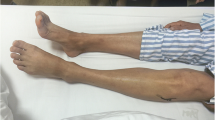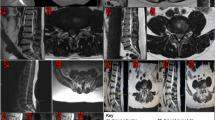Abstract
Foot drop represents a very common reason for a neurologist referral and is often first seen in emergency departments or by a general practitioner. This condition is defined as weakness of ankle dorsiflexion (mainly through tibialis anterior muscle weakness). The most common causes include lower motor neuron lesion, with L4-L5 radiculopathy and peroneal neuropathy being the most frequent ones. Classical diagnostic pathway includes a thorough medical history, detailed neurological examination, radiological studies (MRI of the lumbosacral spine), EMG and nerve conduction studies, and a battery of laboratory tests. The absence of abnormal radiological and neurophysiological findings when searching for the most common causes of foot drop, should raise a red flag and broaden the diagnostic yield for central nervous system pathology (upper motor neuron, UMN) as a possible cause of foot drop. Central causes of isolated foot drop are very rare, with less than 20 cases reported in literature so far, and seven of them being a meningioma. We present a case of a 79-year-old female patient with an isolated foot drop (with no UMN signs on the initial examination) and parasagittal meningioma. Central causes of foot drop should be suspected when foot drop is associated with UMN signs on examination (hyperreflexia of the patellar or ankle jerk and extensor plantar reflex) and when standard diagnostic work-up (MRI of the lumbar spine, EMG and NCS, standard laboratory screening for most common causes of foot drop) is negative or inconclusive. Although very rare, central lesions present a far more serious cause of foot drop and require a more urgent diagnostic work up and a potential neurosurgical referral and treatment. Keeping in mind the possible central causes of foot drop would eliminate unnecessary diagnostic work up and avoid delayed diagnosis and treatment.



Similar content being viewed by others
References
Stewart JD (2008) Foot drop: where, why and what to do? Pract Neurol 8(3):158–169
Daniels SP, Feinberg JH, Carrino JA, Behzadi AH, Sneag DB (2018) MRI of foot drop: how we do it. Radiology 289(1):9–24
Pichiorri F, Onesti E, Tartaglia G, Inghilleri M (2016) Foot drop of central origin: a misleading alteration of nerve conduction study. Neurol Sci 37(5):811–813
Dolev A, Robinson D, Yassin M (2018) A central nervous system tumor mimicking a lumbar spine pathology causing acute foot drop: a case report. J Orthop Case Rep 8(5):78–81
Narenthiran G, Leach P, Holland J (2011) Clinical features of central isolated unilateral foot drop: a case report and review of the literature. Surg Neurol Int 2(1):27
Kim JY, Kim DK, Yoon SH (2015) Isolated painless foot drop due to cerebral infarction mimicking lumbar radiculopathy: a case report. Korean J Spine 12(3):210
Lee Y-S, Wang P-Y (2009) Foot drop caused by a brain tumor: a case report. Acta Neurol Taiwan 18(2):130–131
Poage C, Roth C, Scott B (2016) Peroneal nerve palsy: evaluation and management. J Am Acad Orthop Surg 24(1):1–10
Tural S, Konya D, Sun H (2007) Foot drop: the first sign of an intracranial tumour. J Clin Neurosci 14:490–492
Westhout FD, Paré LS, Linskey ME (2007) Central causes of foot drop: rare and underappreciated differential diagnoses. J Spinal Cord Med 30(1):62–66
Lath R, Rajshekhar V (1996) Unilateral foot drop. Postgrad Med J 72(851):573–574
Baysefer A, Erdoǧan E, Sali A, Sirin S, Seber N (1998) Foot drop following brain tumors: case reports. Minim Invasive Neurosurg 41(2):97–98
Eskandary H, Hamzei A, Yasamy MT (1995) Foot drop following brain lesion. Surg Neurol 43(1):89–90
Ozdemir N, Citak G, Acar UD (2004) Spastic foot drop caused by a brain tumour: a case report. Br J Neurosurg 18(3):314–315
Tun K, Türkoǧlu ÖF, Okutan Ö, Gürcan O, Çelikmez RC, Beşkonakli E (2006) Foot drop as a result of bilateral parasagittal meningioma: a case report. Turk Neurosurg 16(2):94–96
Author information
Authors and Affiliations
Corresponding author
Ethics declarations
Conflict of interest
The authors declare that they have no conflict of interest.
Ethical approval
This article does not contain studies with animals by the author.
Informed consent
Informed consent was obtained from all individual participants included in the study.
Additional information
Publisher's Note
Springer Nature remains neutral with regard to jurisdictional claims in published maps and institutional affiliations.
Rights and permissions
About this article
Cite this article
Bilić, H., Hančević, M., Sitaš, B. et al. A rare case of parasagittal meningioma causing isolated foot drop: case report and review of the literature. Acta Neurol Belg 121, 555–559 (2021). https://doi.org/10.1007/s13760-019-01255-8
Received:
Accepted:
Published:
Issue Date:
DOI: https://doi.org/10.1007/s13760-019-01255-8




